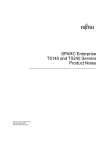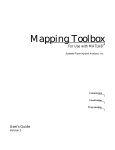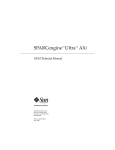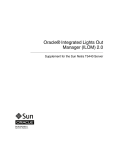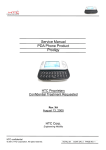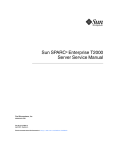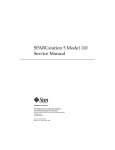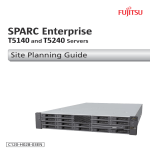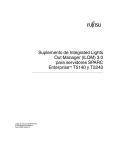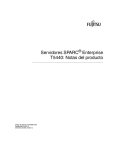Download Sun SPARC Enterprise T5140 and T5240 Servers Product Notes
Transcript
Sun SPARC Enterprise T5140 and T5240 Servers
Product Notes
Part No.: Mfg. No.: E21413-04
February 2012
Copyright © 2008, 2012, Oracle and/or its affiliates. All rights reserved.
Late-breaking information about the server. An HTML document collection is also available.
FUJITSU LIMITED provided technical input and review on portions of this material.
This software and related documentation are provided under a license agreement containing restrictions on use and disclosure and are protected by
intellectual property laws. Except as expressly permitted in your license agreement or allowed by law, you may not use, copy, reproduce, translate,
broadcast, modify, license, transmit, distribute, exhibit, perform, publish, or display any part, in any form, or by any means. Reverse engineering,
disassembly, or decompilation of this software, unless required by law for interoperability, is prohibited.
The information contained herein is subject to change without notice and is not warranted to be error-free. If you find any errors, please report them to us
in writing.
If this is software or related software documentation that is delivered to the U.S. Government or anyone licensing it on behalf of the U.S. Government, the
following notice is applicable:
U.S. GOVERNMENT RIGHTS. Programs, software, databases, and related documentation and technical data delivered to U.S. Government customers
are "commercial computer software" or "commercial technical data" pursuant to the applicable Federal Acquisition Regulation and agency-specific
supplemental regulations. As such, the use, duplication, disclosure, modification, and adaptation shall be subject to the restrictions and license terms set
forth in the applicable Government contract, and, to the extent applicable by the terms of the Government contract, the additional rights set forth in FAR
52.227-19, Commercial Computer Software License (December 2007). Oracle America, Inc., 500 Oracle Parkway, Redwood City, CA 94065.
This software or hardware is developed for general use in a variety of information management applications. It is not developed or intended for use in any
inherently dangerous applications, including applications which may create a risk of personal injury. If you use this software or hardware in dangerous
applications, then you shall be responsible to take all appropriate fail-safe, backup, redundancy, and other measures to ensure its safe use. Oracle
Corporation and its affiliates disclaim any liability for any damages caused by use of this software or hardware in dangerous applications.
Oracle and Java are registered trademarks of Oracle and/or its affiliates. Other names may be trademarks of their respective owners.
AMD, Opteron, the AMD logo, and the AMD Opteron logo are trademarks or registered trademarks of Advanced Micro Devices. Intel and Intel Xeon are
trademarks or registered trademarks of Intel Corporation. All SPARC trademarks are used under license and are trademarks or registered trademarks of
SPARC International, Inc. UNIX is a registered trademark licensed through X/Open Company, Ltd.
This software or hardware and documentation may provide access to or information on content, products, and services from third parties. Oracle
Corporation and its affiliates are not responsible for and expressly disclaim all warranties of any kind with respect to third-party content, products, and
services. Oracle Corporation and its affiliates will not be responsible for any loss, costs, or damages incurred due to your access to or use of third-party
content, products, or services.
Copyright © 2008, 2012, Oracle et/ou ses affiliés. Tous droits réservés.
Entrée et revue tecnical fournies par FUJITSU LIMITED sur des parties de ce matériel.
Ce logiciel et la documentation qui l’accompagne sont protégés par les lois sur la propriété intellectuelle. Ils sont concédés sous licence et soumis à des
restrictions d’utilisation et de divulgation. Sauf disposition de votre contrat de licence ou de la loi, vous ne pouvez pas copier, reproduire, traduire,
diffuser, modifier, breveter, transmettre, distribuer, exposer, exécuter, publier ou afficher le logiciel, même partiellement, sous quelque forme et par
quelque procédé que ce soit. Par ailleurs, il est interdit de procéder à toute ingénierie inverse du logiciel, de le désassembler ou de le décompiler, excepté à
des fins d’interopérabilité avec des logiciels tiers ou tel que prescrit par la loi.
Les informations fournies dans ce document sont susceptibles de modification sans préavis. Par ailleurs, Oracle Corporation ne garantit pas qu’elles
soient exemptes d’erreurs et vous invite, le cas échéant, à lui en faire part par écrit.
Si ce logiciel, ou la documentation qui l’accompagne, est concédé sous licence au Gouvernement des Etats-Unis, ou à toute entité qui délivre la licence de
ce logiciel ou l’utilise pour le compte du Gouvernement des Etats-Unis, la notice suivante s’applique :
U.S. GOVERNMENT RIGHTS. Programs, software, databases, and related documentation and technical data delivered to U.S. Government customers
are "commercial computer software" or "commercial technical data" pursuant to the applicable Federal Acquisition Regulation and agency-specific
supplemental regulations. As such, the use, duplication, disclosure, modification, and adaptation shall be subject to the restrictions and license terms set
forth in the applicable Government contract, and, to the extent applicable by the terms of the Government contract, the additional rights set forth in FAR
52.227-19, Commercial Computer Software License (December 2007). Oracle America, Inc., 500 Oracle Parkway, Redwood City, CA 94065.
Ce logiciel ou matériel a été développé pour un usage général dans le cadre d’applications de gestion des informations. Ce logiciel ou matériel n’est pas
conçu ni n’est destiné à être utilisé dans des applications à risque, notamment dans des applications pouvant causer des dommages corporels. Si vous
utilisez ce logiciel ou matériel dans le cadre d’applications dangereuses, il est de votre responsabilité de prendre toutes les mesures de secours, de
sauvegarde, de redondance et autres mesures nécessaires à son utilisation dans des conditions optimales de sécurité. Oracle Corporation et ses affiliés
déclinent toute responsabilité quant aux dommages causés par l’utilisation de ce logiciel ou matériel pour ce type d’applications.
Oracle et Java sont des marques déposées d’Oracle Corporation et/ou de ses affiliés.Tout autre nom mentionné peut correspondre à des marques
appartenant à d’autres propriétaires qu’Oracle.
AMD, Opteron, le logo AMD et le logo AMD Opteron sont des marques ou des marques déposées d’Advanced Micro Devices. Intel et Intel Xeon sont des
marques ou des marques déposées d’Intel Corporation. Toutes les marques SPARC sont utilisées sous licence et sont des marques ou des marques
déposées de SPARC International, Inc. UNIX est une marque déposée concédée sous licence par X/Open Company, Ltd.
Ce logiciel ou matériel et la documentation qui l’accompagne peuvent fournir des informations ou des liens donnant accès à des contenus, des produits et
des services émanant de tiers. Oracle Corporation et ses affiliés déclinent toute responsabilité ou garantie expresse quant aux contenus, produits ou
services émanant de tiers. En aucun cas, Oracle Corporation et ses affiliés ne sauraient être tenus pour responsables des pertes subies, des coûts
occasionnés ou des dommages causés par l’accès à des contenus, produits ou services tiers, ou à leur utilisation.
Please
Recycle
SPARC Enterprise T5140 and T5240
Product Notes
These product notes contain important and late-breaking information about the Sun
SPARC Enterprise® T5140 and T5240 servers from Oracle.
This information is organized into the following sections:
■
“General Information” on page 1
■
“Supported Versions of Oracle Solaris and System Firmware” on page 2
■
“Oracle Solaris OS and Firmware Requirements for Certain Features” on page 4
■
“Preinstalled Software” on page 5
■
“Patch Information” on page 6
■
“Rules for PCIe Slot Use by Certain HBA Cards” on page 8
■
“FB-DIMM Voltage Compatibility” on page 8
■
“Known Product Issues” on page 9
■
“Product Documentation Errata” on page 21
General Information
This section contains information of a general interest.
Major New Features
The following new feature has been added to the servers in this release:
■
Firmware release 7.3.0.c, which includes support for the following new features:
1
■
Support for the Oracle VM for SPARC 2.0 software
■
Support for new and legacy power supply units (PSUs) in the same chassis.
Documentation, Support, and Training
These web sites provide additional resources:
■
Documentation
http://www.oracle.com/technetwork/indexes/documentation/
index.html
■
Support https://support.oracle.com
■
Training https://education.oracle.com
Note – Information in these product notes supersedes the information in the SPARC
Enterprise T5140 and T5240 documentation sets.
Supported Versions of Oracle Solaris and
System Firmware
The following table lists the versions of the Oracle Solaris Operating System (Oracle
Solaris) and system firmware supported in this release.
Your server is preinstalled with the latest supported OS, patches and firmware. If
you decide to install some other supported version, be certain to also install the
patches required by that version. For information on OS patch requirements, see the
following:
2
■
“Patches Required for the Oracle Solaris 10 10/08 OS” on page 6
■
“Patches Required for the Oracle Solaris 10 5/08 OS” on page 6
■
“Patches Required for the Oracle Solaris 10 8/07 OS” on page 7.
Sun SPARC Enterprise T5140 and T5240 Servers Product Notes • February 2012
Note – If you install an OS over the preinstalled OS (even if it is the same version)
you will overwrite the supplementary software that was preinstalled at the factory.
See “Preinstalled Software” on page 5 for more information on this additional
preinstalled software.
TABLE 1
Supported Versions of the Operating System and Firmware
Component
Supported Versions
OS
Oracle Solaris 10 8/07 OS (U4) plus mandatory patches – Minimum
supported OS
Oracle Solaris 10 5/08 OS (U5) plus patches
Oracle Solaris 10 10/08 OS (U6)
Oracle Solaris 10 5/09 OS (U7)
Oracle Solaris 10 5/10 OS (U9)
Firmware
System Firmware 7.1.0.b – Minimum supported System Firmware version
System Firmware 7.1.0.g
System Firmware 7.1.3.d
System Firmware 7.1.3.e
System Firmware 7.1.6
System Firmware 7.1.6.d
System Firmware 7.1.8
System Firmware 7.2.0
System Firmware 7.2.2.d
System Firmware 7.2.2.e
System Firmware 7.2.4.e
System Firmware 7.2.7.g
System Firmware 7.2.10.a (preinstalled)
System Firmware 7.3.0
System Firmware 7.3.0.c or later
SPARC Enterprise T5140 and T5240 Product Notes
3
Oracle Solaris OS and Firmware
Requirements for Certain Features
The following table identifies them minimum OS and firmware versions required to
support certain features.
TABLE 2
Minimum Firmware Version Requirements for Certain Features
Feature
Minimum Firmware Version
Minimum OS Version
12 or 24 FB-DIMM system
configuration
7.1.0.g
N/A
Systems operating with DC power
supplies
7.1.6.d
Oracle Solaris 10 10/08
OS
Systems using the External I/O
Expansion Unit
7.1.6.d
Oracle Solaris 10 10/08
OS
Systems using low voltage (LV) 1.5V
FB-DIMMs*
7.1.6.d
N/A
Different FB-DIMM capacities on
different CPUs*
7.1.7.f
N/A
Oracle ILOM 2.0 firmware (with 1.2- or 7.1.8
1.4-GHz processors
N/A
Oracle ILOM 3.0 firmware
7.2.0
N/A
1.6 GHz processors
7.2.2.e
Oracle Solaris 10 8/07
OS
LDOMs 1.2
7.2.2.e
Oracle Solaris 10 5/09
OS
Flash Accelerator F20 PCIe Card
7.2.4.e
N/A
LDoms 1.3
7.2.7.d
Oracle Solaris 10 10/09
OS
OpenOracle Solaris
2009.06 OS
Oracle VM for SPARC 2.0
7.3.0.c or later
Oracle Solaris 10 5/10
OS
* Follow all system memory configuration rules and restrictions as defined in the
SPARC Enterprise T5140 and T5240 Servers Service Manual.
4
Sun SPARC Enterprise T5140 and T5240 Servers Product Notes • February 2012
Note – To benefit from the accumulated features, enhancements, and fixes, upgrade
your system firmware to the most recent version available.
Preinstalled Software
The following table lists the software preinstalled on your server.
TABLE 3
Preinstalled Software
Software
Location
Function
Oracle Solaris 10 10/09
Root disk Slice 0 (and on Slice 3 in the
ABE) with patches
Operating system
Oracle Studio 1.2 U1
developer tools
/opt/sunstudio12.1
C, C++, and Fortran compiler
LDoms Manager 1.3
/opt/SUNWldm/
Manages Logical Domains
LDoms MIB
/opt/SUNWldmib
LDoms Management Information Base
CMT Tools 1.2
/opt/sunstudio12.1/bin
/opt/sunstudio12.1/prod/bin
Sun Studio Developer Tools
Code Generator for
SPARC Systems 4.3.2
/opt/gcc and /opt/SUNW0scgfss
GCC compiler for SPARC Systems
Note – The Oracle Solaris OS is preinstalled both in root disk Slice 0 for normal
operations, and in Slice 3 along with Live Upgrade software to provide an Alternate
Boot Environment (ABE). The ABE enables you to upgrade the OS or perform
system maintenance tasks without reducing performance. An identical (bootable)
copy of the root partition (including the OS, EIS, and applications) is installed as an
ABE in Slice 3.
SPARC Enterprise T5140 and T5240 Product Notes
5
Patch Information
This section provides information about patch requirements.
Note – You should install the latest Oracle Solaris OS kernel update (KU) patch to
be certain your system has the most current fixes.
Patches Required for the Oracle Solaris 10 10/08
OS
At the time this document is published, no patches are required for this distribution.
Patches Required for the Oracle Solaris 10 5/08
OS
The following table identifies the mandatory patches for the Oracle Solaris 10 5/08
OS.
TABLE 4
6
Mandatory Patches for the Oracle Solaris 10 5/08 OS
Patch ID
Description
137111-01 or later
Kernel patch
137291-01 or later
n2cp driver patch
138048-01 or later
nxge patch
Sun SPARC Enterprise T5140 and T5240 Servers Product Notes • February 2012
Patches Required for the Oracle Solaris 10 8/07
OS
The following table identifies the mandatory patches for the Oracle Solaris 10 8/07
OS.
TABLE 5
Mandatory Patches for the Oracle Solaris 10 8/07 OS
Patch ID
Description
124235-02 or later
libpam.so.1 patch
125369-13 or later
Fault Manager patch
125416-06 or later
UFS utilities patch
125476-02 or later
libc_psr_hwcap.so.1 patch
126434-05 or later
raidctl patch
127127-11 or later
Kernel patch
137111-01 or later
Kernel patch
Patches for Option Cards
If you add option cards to your server, refer to the documentation and README
files for each card to determine if additional patches are needed.
SPARC Enterprise T5140 and T5240 Product Notes
7
Rules for PCIe Slot Use by Certain HBA
Cards
Some optional I/O cards are restricted to particular PCIe slots to enable more
effective cooling for themselves and other components in the chassis. The following
chart identifies the cards that have this restriction.
TABLE 6
PCIe Slot Usage Rules for Certain HBA Cards
PCIe Slots
Allowed
System
HBA Card
T5140
Flash Accelerator F20 PCIe Card
T5240
1, 2
Notes
Limit, 2 cards per system
Internal connectors cannot be used
StorageTek x8 SAS RAID HBA
1
Limit, 1 card per system
StorageTek SAS RAID External HBA
1
Limit, 1 card per system
PCI Express Quad Gigabit Ethernet UTP
1, 2
This card is not allowed in slot 0.
PCI Express Dual 10-Gigabit Ethernet Fiber
1, 2
This card is not allowed in slot 0.
Flash Accelerator F20 PCIe Card
2, 5
Limit, 2 cards per system
Internal connectors cannot be used
StorageTek x8 SAS RAID HBA
StorageTek SAS RAID External HBA
1
Limit, 1 card per system
1, 2, 4, 5
Limit, 4 cards per system
PCI Express Quad Gigabit Ethernet UTP
1, 2, 3*, 4, 5
In 8-disk systems, this card is not
allowed in slot 0.
* In 16-disk systems, this card is not
allowed in slot 0 or slot 3.
PCI Express Dual 10-Gigabit Ethernet Fiber
1, 2, 3*, 4, 5
In 8-disk systems, this card is not
allowed in slot 0.
* In 16-disk systems, this card is not
allowed in slot 0 or slot 3.
FB-DIMM Voltage Compatibility
Servers were originally shipped with 1.8 V FB-DIMMs in early 2008 until 1.5 V
FB-DIMMs were qualified in late 2008. If you want to add additional memory to a
server purchased before the release of 1.5 V FB-DIMMs, you must replace all 1.8
FB-DIMMs with 1.5 V FB-DIMMs and upgrade to Firmware 7.1.6 or later.
8
Sun SPARC Enterprise T5140 and T5240 Servers Product Notes • February 2012
Mixing of 1.8 V and 1.5 V FB-DIMMs is not supported.
Known Product Issues
This section describes issues that are known to affect the T5140 and T5240 servers.
The issue descriptions are organized as follows:
■
“Hardware and Mechanical Issues” on page 9
■
“Firmware Issues” on page 13
■
“Oracle Solaris OS Issues” on page 14
Hardware and Mechanical Issues
This section describes hardware issues known to exist at this release of the servers.
TABLE 7
Hardware-Related Issues on the Sun SPARC Enterprise T5140 and T5240 Servers
CR ID
Description
Workaround
N/A
When the server is plugged in, but is idle or not
turned on, it is possible for the internal
temperature sensor to falsely report a lowtemperature warning. This might happen if the
ambient temperature is at the low end of the
allowed temperature range. A -7 degree C offset
is built into the sensor circuit to compensate for
the influence of heat sources near the
thermocouple.
If show environment reports a low
temperature warning while the server is not
running, verify that the ambient temperature is
within the range specified in the Site Planning
Guide.
N/A
When the system is initialized, firmware is
loaded and occupies approximately 128 MB to
352 MB of the host memory. The banner and
other software utilities report an amount of
memory minus the amount of memory that is
occupied by firmware.
Be aware that the banner reports the amount of
memory less the amount used by the firmware.
N/A
When a RAID volume is created using internal
drives, the LEDs on the drives configured in the
RAID volume all blink simultaneously at an
interval of approximately 16 seconds.
This behavior is normal and can be ignored.
N/A
The On/Standby portion of the service label
contains an error. It says to press and hold the
On/Standby button for “5 seconds”. It should
say “4 seconds”.
Note - This error appears on all SPARC
Enterprise T5140 and T5240 server
configurations.
SPARC Enterprise T5140 and T5240 Product Notes
9
TABLE 7
Hardware-Related Issues on the Sun SPARC Enterprise T5140 and T5240 Servers (Continued)
CR ID
Description
Workaround
N/A
Two illustrations in the service label show the
top cover button in the wrong location. The
button is near the right edge of the server.
Note - This error appears on all SPARC
Enterprise T5140 and T5240 servers.
N/A
The portion of the service label that cautions
about the weight of the server gives the wrong
weight. It should say “42 lb” and “19 kg”.
Note - This error appears on SPARC Enterprise
T5140 server configurations.
N/A
In the Interior Service Label CRU and FRU
Procedures portion of the service label, the
letters “PBD” should say “PDB”.
Note - This error appears on all SPARC
Enterprise T5140 and T5240 servers.
N/A
The FM Status Indicator portion of the service
Note - This error appears on SPARC Enterprise
label has an erroneous statement. Where it says, T5240 server configurations.
“In front of FM on FanBD” it should say, “on top
of FM”.
N/A
The drawing showing the cable management
arm being rotated represents the wrong server
model. It should show the SPARC Enterprise
T5240 server,
6793093
When using a Type 6 keyboard attached directly Only Type 7 keyboards are supported for local
connections. Do not use any other keyboard
to the server, the server might hang during
type.
initial boot.
N/A
A faulty USB port constantly asserts and deasserts itself. This condition produces errors in
the system log, such as the following:
Current : /MB/I_USB1 : Predictive
Failure Asserted
Current : /MB/I_USB1 : Predictive
Failure Deasserted
Note - This error appears on SPARC Enterprise
T5240 server configurations.
There is no workaround for this error.
False Intermittent SATA Errors Seen on SPARC
Enterprise T5120, T5220, T5140, and T5240 Systems (CR
6880299)
While booting, some systems with SATA DVD devices intermittently log extraneous
port failure errors in /var/adm/messages. The following shows an example of
typical error messages for the T5x40 server:
/pci@400/pci@0/pci@1/pci@0/usb@0,1 (ohci1): Connecting device on port 1 failed
/pci@400/pci@0/pci@1/pci@0/usb@0,2 (ehci0): Connecting device on port 2 failed
Workaround: You can ignore these messages.
10
Sun SPARC Enterprise T5140 and T5240 Servers Product Notes • February 2012
Hard Drives Can Be Difficult to Remove From Right-Side
Drive Bays
Hard drives in the right-side drive bays can be difficult to remove.
Workaround: Until a mechanical fix is implemented, use the following procedure to
remove hard drives from right-side drive bays.
▼ Hard Drive Removal Procedure
1. Press the drive to the right.
See Step 1 in the following figure.
2. Push in on the drive, while holding it pressed to the right.
See Ste[2 in the following figure.
3. Press the drive eject button and pull the eject lever.
See Step 3 in the following figure.
4. Use the eject lever to slide the drive out of the bay.
See Step 4 in the following figure.
SPARC Enterprise T5140 and T5240 Product Notes
11
Misalignment of Backplane to HDD Cage in Some 8- and
16-Disk Systems
It has been found in some 8-disk and 16-disk systems that SSDs and/or disk drives
cannot be fully inserted the hard drive bays. This problem can result from
misalignment between the backplane and hard drive cage.
If you have a system that exhibits this problem, you may be able to correct the
backplane misalignment using a retention bracket. This is an orderable FRU (field
replaceable unit), part number 542-0355.
Instructions for using the retention bracket are included with the part.
Note – In some cases, the retention bracket can be installed without removing the
HDD cage. In cases where the HDD cage must be removed, the procedure must be
performed by qualified service personnel.
Note on Bus Bar Assembly Between Power Distribution
Board and Motherboard
The motherboard is connected to the power distribution board with a ribbon cable
and a bus bar assembly. When installing a motherboard, you must ensure that the
bus bar screws are tightened securely.
In addition, when installing a replacement power distribution board (PDB), you
must transfer the bus bar assembly from the old PDB to the new PDB.
Note – The PDB on the SPARC Enterprise T5240 has additional bus bar connections
to the power supply backplane.
When reassembling the system, ensure that all bus bar screws are tightened securely.
Caution – Loose bus bar screws can cause arcing between the bus bar assembly and
other internal components, potentially damaging the server and posing a fire
hazard.
For detailed motherboard and power distribution board installation procedures, see
the Sun SPARC Enterprise T5140 and T5240 Servers Service Manual.
12
Sun SPARC Enterprise T5140 and T5240 Servers Product Notes • February 2012
Firmware Issues
This section describes issues present in the system or component firmware.
SCSI Transport Errors Under Heavy Load in Some
Systems Equipped with 4 USB Drives (CR 6945900)
Under very heavy load to the USB subsystem, some SCSI errors might appear.
Perform a power supply reset to fix the errors.
Incorrect Margin Voltage 1.320V Exceeded High Limit
Warnings Appear After Service Processor Warm Reset
(CR 6998751)
In some cases, incorrect margin voltage exceeded errors appear after a warm reset of
the service processor. For example, the following may appear in the vbsc.log file:
Nov
6 11:28:28 NOTICE: [CMP0
] Adjusted vcore voltage 1.320V
The show /SYS/MB/V_VCOREL command also reports the voltage 1.320V exceeded
high limit warning:
-> show /SYS/MB/V_VCOREL
/SYS/MB/V_VCOREL
Targets:
Properties:
type = Voltage
ipmi_name = /MB/V_VCOREL
class = Threshold Sensor
value = 1.320 Volts
upper_nonrecov_threshold = 1.452 Volts
upper_critical_threshold = 1.416 Volts
upper_noncritical_threshold = 1.380 Volts
lower_noncritical_threshold = 1.272 Volts
lower_critical_threshold = 1.224 Volts
lower_nonrecov_threshold = 1.188 Volts
alarm_status = cleared
This issue causes the system processor(s) to operate at a reduced voltage.
SPARC Enterprise T5140 and T5240 Product Notes
13
Resolution: Do one of the following:
■
Power cycle the system.
■
Install System Firmware 7.3.0.c or later.
SATA DVD Device Disappears After Attempted Write
(CR 7050587)
In some situations, the SATA DVD device disappears from OBP and the Oracle
Solaris OS after an attempted large-file write operation to DVD-R or DVD-RW
media.
Workaround:
Reboot the server and attempt the DVD write operation with a different media type.
If the write operation still fails, contact Oracle Support for a firmware update for the
USB/SATA controller.
SSDs and RAID HBAs Require Firmware Updates To
Support RAID Configurations With SSDs
To use the Storage 32GB SLC SATA Solid State Drives with StorageTek SAS RAID
HBAs, the SSD firmware and HBA firmware must be at the following levels:
■
Minimum SSD firmware level: 8855
■
Minimum RAID HBA firmware level: 16732
Note – The RAID HBA firmware requirement applies to both StorageTek x8 SAS
RAID HBAs and StorageTek SAS RAID External HBAs.
To do this, download and install the patch kits that apply to your platform’s
operating system. For additional patch information and instructions for
downloading and installing the required patches, go to
(http://www.sunsolve.sun.com).
Oracle Solaris OS Issues
This section describes issues related to the Oracle Solaris OS known to affect this
release of the SPARC Enterprise T5140 and T5240 servers.
14
Sun SPARC Enterprise T5140 and T5240 Servers Product Notes • February 2012
Boot Drive May Report “drive type unknown” for Oracle
Solaris format Command (CR 6886514)
During a period extending from mid-September to early October 2009
(approximately 3 weeks) a patch was preinstalled on some servers, which
introduced a latent bug into those systems. The bug is described as “latent” because
it is activated only when the Oracle Solaris format command is used. Otherwise, the
bug has no effect on system behavior or performance.
When a system administrator or other user with root (/) privileges enters the
format command on a system containing this bug, the boot drive will report “drive
type unknown”. This fault condition presents two problems for the administrator:
■
The administrator will be unable to access unused portions of the boot drive
because of the unknown drive type error.
■
The presence of mounted partitions blocks use of the format utility’s auto
configure feature. Attempts to bypass this restriction by booting from the network
or removable media could put the system in an unbootable state.
The Workaround section below describes a procedure you can use to recover from
this “drive type unknown” fault mode without the risks associated with the network
and media boot methods.
Workaround: Perform the sequence of steps shown in EXAMPLE 1. To simplify
tracking of the procedure, the steps are organized into nine sections:
■
Determine whether or not the system’s boot device is affected.
■
Shut the server down and restart in single user mode with the root file system
mounted read only.
■
Mount the tmpfs /tmp filesystem to provide a working area.
■
Capture the boot drive’s existing vtoc in a file stored in /tmp.
■
Make a copy of the fmthard utility for use in the /tmp work area.
■
Set and export the NOINUSE_CHECK variable to allow the format command full
access to the boot drive.
■
Run the format utility to restore the drive’s “type.”
■
Use the fmthard command and stored information to complete the recovery.
■
Verify the success of the recovery.
SPARC Enterprise T5140 and T5240 Product Notes
15
EXAMPLE 1
Procedure for Recovering a Boot Drive’s “drive type”
1. Determine if the boot drive is affected:
root@host-1 # uname -a
SunOS host-1 5.10 Generic_141414-10 sun4v sparc SUNW,SPARC-Enterprise-T5240
root@host-1 # mount -p | head -1
/dev/dsk/c0t0d0s0 - / ufs - no rw,intr,largefiles,logging,xattr,onerror=panic
root@host-1 # format c0t0d0s0 <========== boot device determined previously
/dev/dsk/c0t0d0s0 is currently mounted on /. Please see umount(1M).
/dev/dsk/c0t0d0s1 is currently used by swap. Please see swap(1M).
FORMAT MENU:
disk
type
partition
current
format
repair
label
analyze
defect
backup
verify
save
inquiry
volname
!<cmd>
quit
format> disk
-
select a disk
select (define) a disk type
select (define) a partition table
describe the current disk
format and analyze the disk
repair a defective sector
write label to the disk
surface analysis
defect list management
search for backup labels
read and display labels
save new disk/partition definitions
show vendor, product and revision
set 8-character volume name The jumpstart install process
execute <cmd>, then return
The jumpstart install process
AVAILABLE DISK SELECTIONS:
0. c0t0d0 <drive type unknown>
/pci@0/pci@0/pci@2/scsi@0/sd@0,0
Specify disk (enter its number)[0]: ^C
format> quit
root@host-1 #
<========== problem indication
<========== quit with <ctrl>C
2. Shut the server down; then bring it up in single user mode with root filesystem
mounted read only.
root@host-1 # init 0
Oct 20 16:26:56 host-1 syslogd: going down on signal 15
svc.startd: The system is down.
syncing file systems... done
Program terminated
16
Sun SPARC Enterprise T5140 and T5240 Servers Product Notes • February 2012
SPARC Enterprise T5240, No Keyboard
Copyright 2011 Oracle and/or its affiliates. All rights reserved.
OpenBoot 4.30.4, 3968 MB memory available, Serial #xxxxxxxx.
Ethernet address xx:xx:xx:xx:xx:xx, Host ID: xxxxxxxx.
{0} ok boot -m milestone=none
Boot device: /pci@0/pci@0/pci@2/scsi@0/disk@0,0:a
milestone=none
Copyright 1983-2011 Oracle and/or its affiliates.
Use is subject to license terms.
Booting to milestone "none".
Requesting System Maintenance Mode
(See /lib/svc/share/README for more information.)
Console login service(s) cannot run
File and args: -m
All rights reserved.
Root password for system maintenance (control-d to bypass): <====== login
single user mode single-user privilege assigned to /dev/console.
Entering System Maintenance Mode
Oct 20 18:06:11 su: ’su root’ succeeded for root on /dev/console
Sourcing //.profile-EIS.....
3. Mount the tmpfs /tmp filesystem to provide a working area.
root@ # mount -F tmpfs /tmp
root@ # cd /tmp
4. Capture the boot drive’s existing vtoc in a file stored in /tmp. Use the raw
device of the boot device determined at the beginning -- i.e ., use
/dev/rdsk/c?t?d?s? not /dev/dsk/c?t?d?s?
root@ # prtvtoc /dev/rdsk/c0t0d0s0 > /tmp/vtoc
<==== boot disk vtoc saved
in /tmp/vtoc
5. Make a copy of the fmthard utility for use in the /tmp work area.
root@ #
cp /usr/sbin/fmthard /tmp
6. Set and export the NOINUSE_CHECK variable:
root@ # setenv NOINUSE_CHECK=1
root@ # export NOINUSE_CHECK
7. Run the format utility to restore the drive’s “type”.
root@ # format
Searching for disks...done
AVAILABLE DISK SELECTIONS:
SPARC Enterprise T5140 and T5240 Product Notes
17
0. c0t0d0 <drive type unknown>
<===== drive type unknown is the issue
/pci@0/pci@0/pci@2/scsi@0/sd@0,0
Specify disk (enter its number): 0
Format will now present the following menu, choose 0. Auto configure
AVAILABLE DRIVE TYPES:
0. Auto configure
1. Quantum ProDrive 80S
2. Quantum ProDrive 105S
[...]
17. Zip 250
18. Peerless 10GB
19. other
Specify disk type (enter its number): 0
c0t0d0: configured with capacity of 68.35GB
<SUN72G cyl 14087 alt 2 hd 24 sec 424>
selecting c0t0d0
[disk formatted]
<======= drive type corrected
<======= drive type corrected
Following Auto configure, the correct drive value should be reported.
FORMAT MENU:
disk
- select a disk
type
- select (define) a disk type
partition - select (define) a partition table
current
- describe the current disk
format
- format and analyze the disk
repair
- repair a defective sector
label
- write label to the disk
analyze
- surface analysis
defect
- defect list management
backup
- search for backup labels
verify
- read and display labels
save
- save new disk/partition definitions
inquiry
- show vendor, product and revision
volname
- set 8-character volume name The jumpstart install process
!<cmd>
- execute <cmd>, then return
quit
format> label
Ready to label disk, continue? y
format> quit
root@ #
8. Use the fmthard command and stored information to complete the recovery.
root@ # /tmp/fmthard -s /tmp/vtoc /dev/rdsk/c0t0d0s0
used to capture vtoc.
18
<=== raw boot device
Sun SPARC Enterprise T5140 and T5240 Servers Product Notes • February 2012
fmthard:
root@ #
New volume table of contents now in place.
9. Verify the success of the recovery.
root@ # format
Searching for disks...done
AVAILABLE DISK SELECTIONS:
0. c0t0d0 <SUN72G cyl 14087 alt 2 hd 24 sec 424>
/pci@0/pci@0/pci@2/scsi@0/sd@0,0
Specify disk (enter its number): 0
selecting c0t0d0
[disk formatted]
FORMAT MENU:
disk
- select a disk
type
- select (define) a disk type
partition - select (define) a partition table
current
- describe the current disk
format
- format and analyze the disk
repair
- repair a defective sector
label
- write label to the disk
analyze
- surface analysis
defect
- defect list management
backup
- search for backup labels
verify
- read and display labels
save
- save new disk/partition definitions
inquiry
- show vendor, product and revision
volname
- set 8-character volume name The jumpstart install process
!<cmd>
- execute <cmd>, then return
quit
format> partition
PARTITION MENU:
0
1
2
3
4
5
6
7
select
modify
name
print
label
-
change ‘0’ partition
change ‘1’ partition
change ‘2’ partition
change ‘3’ partition
change ‘4’ partition
change ‘5’ partition
change ‘6’ partition
change ‘7’ partition
select a predefined table
modify a predefined partition table
name the current table
display the current table
write partition map and label to the disk
SPARC Enterprise T5140 and T5240 Product Notes
19
!<cmd> - execute <cmd>, then return
quit
partition> print
Current partition table (original):
Total disk cylinders available: 14087 + 2 (reserved cylinders)
Part
0
1
2
3
4
5
6
7
Tag
root
swap
backup
unassigned
unassigned
unassigned
unassigned
unassigned
Flag
wm
wu
wm
wm
wu
wu
wu
wu
Cylinders
825 - 3298
0 - 824
0 - 14086
3299 - 5772
0
0
0
0
Size
12.00GB
4.00GB
68.35GB
12.00GB
0
0
0
0
Blocks
(2474/0/0)
25175424
(825/0/0)
8395200
(14087/0/0) 143349312
(2474/0/0)
25175424
(0/0/0)
0
(0/0/0)
0
(0/0/0)
0
(0/0/0)
0
partition> quit
FORMAT MENU:
disk
type
partition
current
format
repair
label
analyze
defect
backup
verify
save
inquiry
volname
!<cmd>
quit
format> disk
-
select a disk
select (define) a disk type
select (define) a partition table
describe the current disk
format and analyze the disk
repair a defective sector
write label to the disk
surface analysis
defect list management
search for backup labels
read and display labels
save new disk/partition definitions
show vendor, product and revision
set 8-character volume name The jumpstart install process
execute <cmd>, then return
AVAILABLE DISK SELECTIONS:
0. c0t0d0 <SUN72G cyl 14087 alt 2 hd 24 sec 424>
/pci@0/pci@0/pci@2/scsi@0/sd@0,0
Specify disk (enter its number)[0]:
selecting c0t0d0
[disk formatted]
format> quit
The drive type recovery is complete, reboot the server:
root@ # reboot
syncing file systems... done
20
Sun SPARC Enterprise T5140 and T5240 Servers Product Notes • February 2012
rebooting...
Resetting...
#
SPARC Enterprise T5240, No Keyboard
Copyright 2011 Oracle and/or its affiliates. All rights reserved.
OpenBoot 4.30.4, 3968 MB memory available, Serial #xxxxxxxx.
Ethernet address xx:xx:xx:xx:xx:xx, Host ID: xxxxxxxx.
Boot device: /pci@0/pci@0/pci@2/scsi@0/disk@0,0:a File and args:
SunOS Release 5.10 Version Generic_141414-10 64-bit
Copyright 1983-2011 Oracle and/or its affiliates. All rights reserved.
Use is subject to license terms.
Hostname: host-1
The / file system (/dev/rdsk/c0t0d0s0) is being checked.
Reading ZFS config: done.
host-1 console login:
Boot From SATA DVD Limitation
Oracle Solaris 10 10/08 is the first Oracle Solaris OS to support for booting from a
SATA DVD. Miniroot software in Oracle Solaris S10 8/07 and S10 5/08 lack SATA
driver compatibility, which prevents successful booting from a SATA DVD.
Each version of the Oracle Solaris OS requires a different miniroot update procedure.
They are described separately in an article at the following BigAdmin location:
(http://www.sun.com/bigadmin/features/articles/sparc_sata_patchm
ini.jsp)
Product Documentation Errata
This section describes errors or omissions in the current product documentation.
SPARC Enterprise T5140 and T5240 Product Notes
21
Incorrect Data Cable Routing Diagram for Sun
SPARC Enterprise T5140 Servers With 4-Disk
Backplanes
The service manual data cable routing diagram for 4-disk capable backplanes is
wrong. It shows the cable connected to SAS1. It should be connected to SAS0. This is
the correct diagram:
FIGURE 1
22
Internal Cables for the Onboard SAS Controller Card (Four-Disk Capbable SPARC Enterprise
T5140 Servers)
Sun SPARC Enterprise T5140 and T5240 Servers Product Notes • February 2012
Incorrect Data Cable Routing Diagram for Sun
SPARC Enterprise T5240 Servers With 8-Disk
Backplanes
The service manual data cable routing diagram for 8-disk capable backplanes in
T5240 servers is wrong. It shows a single data cable. There should be two. This is the
correct diagram:
FIGURE 2
Internal Cables for Onboard SAS Controller Cards (Eight-Disk Capable SPARC Enterprise T5240
Servers)
SPARC Enterprise T5140 and T5240 Product Notes
23
Fan Module Missing in Data Cable Routing
Diagram
The service manual cable routing diagram for 8-disk capable backplanes in T5140
servers is missing a fan module in the upper right corner. This is the correct
diagram:
FIGURE 3
Internal Cables for the Onboard SAS Controller Card (Eight-Disk Capable SPARC Enterprise
T5140 Servers)
Incorrect SAS RAID HBA Data Cable Routing
Information for Systems With 8- or 16-Disk
Capable Backplanes (CR 6776592)
The following manuals contain incorrect descriptions of data cable routing between
SAS RAID HBA ports and 8- or 16-disk capable backplanes:
24
Sun SPARC Enterprise T5140 and T5240 Servers Product Notes • February 2012
■
SPARC Enterprise T5140 and T5240 Servers Service Manual
■
Installing the StorageTek SAS RAID HBA Into the SPARC T5120 and T5220 Servers
Corrections for these manuals are described separately below.
Caution – Do not change cable routing in a system that has disk volumes already
built and that are being used successfully. If you change the data cable connections,
you will need to swap hard drives in the backplane so the logical mapping of the
data stored on the drives will be retained.
Corrections for the Service Manual
Currently, the CN0 and CN1 port connections are the opposite of what they should
be. The following list describes the correct SAS data cable connections and provides
illustrations of the correct cable routing:
■
CN0 <--> P2 (J0301)
■
CN1 <--> P3 (J0302)
■
FIGURE 4 in this manual shows the correct cable routing information for eight-disk
capable T5140 servers. Use it in place of the figure shown on page 194 of the
Service Manual.
■
FIGURE 5 in this manual shows the correct cable routing information for eight- or
sixteen-disk capable T5240 servers. Use it in place of the figure shown on page
207 of the Service Manual.
SPARC Enterprise T5140 and T5240 Product Notes
25
FIGURE 4
26
HDD Data Cable Routing for SAS RAID Controller Card in Eight-Disk
Capable SPARC Enterprise T5140 Servers
Sun SPARC Enterprise T5140 and T5240 Servers Product Notes • February 2012
FIGURE 5
HDD Data Cable Routing for SAS RAID Controller Cards in Eight- or Sixteen-Disk Capable
SPARC Enterprise T5240 Servers
Corrections for the HBA Installation Manual
The corrections for the HBA Installation Manual are summarized below:
■
Use FIGURE 4 from this manual in place of Figure 7 in the HBA Installation
Manual.
■
Use FIGURE 5 from this manual in place of Figure 11 in the HBA Installation
Manual.
■
For T5140 servers, change all CN0 and CN1 routing instructions associated with
these figures so that the longer data cable connects CN0 to P2 (J0301) and the
shorter data cable connects CN1 to P3 (J0302).
■
For T5240 servers, change all CN0 and CN1 routing instructions associated with
these figures so that one data cable connects CN0 to P2 (J0301) and the other data
cable connects CN1 to P3 (J0302).
SPARC Enterprise T5140 and T5240 Product Notes
27
■
Use the following table in place of the table shown in Step 6 on page 14 of the
HBA Installation Manual.
Cable
Length
Part Number
(see label on
cable)
HBA
Connector
Hard Drive
Backplane
Connector
Figure
Reference
4-disk backplane
60 cm
530-3893
CN0
P1
Figure 7
8-Disk backplane
45 cm
40 cm
530-3891
530-4077
CN0
CN1
P2
P3
Figure 8
8-disk backplane
40 cm
40 cm
530-4077
530-4077
CN0
CN1
P2
P3
Figure 11
16-disk backplane
40 cm
40 cm
530-4077
530-4077
CN0
CN1
P2
P3
Figure 11
Server Model
T5140
T5240
Corrected FB-DIMM Removal Procedure
In the Sun SPARC Enterprise T5140 and T5240 Servers Service Manual, the FB-DIMM
removal procedure mentions FB-DIMM slot fillers.
FB-DIMM slot fillers are not available, and are not required. Use the following
FB-DIMM removal procedure instead.
▼ Remove FB-DIMMs
Before beginning this procedure, ensure that you are familiar with the cautions and
safety instructions described in the Sun SPARC Enterprise T5140 and T5240 Servers
Service Manual.
1. Extend the server to the maintenance position.
2. Remove power from the server.
3. Remove the top cover.
4. For SPARC Enterprise T5140 servers, disconnect and stow the hard drive data
cable:
a. Unplug the hard drive data cable from J6401 on the motherboard.
b. Remove the hard drive data cable from its seat on the CMP air duct.
28
Sun SPARC Enterprise T5140 and T5240 Servers Product Notes • February 2012
c. Place the hard drive cable end out of the way of the air duct.
5. Rotate the air duct up and toward the front of the system.
6. Press the Fault Locator button on the motherboard to identify the FB-DIMMs
that need to be replaced.
Tip – Make a note of the faulty FB-DIMM location.
Note – For memory configuration information, see the Sun SPARC Enterprise T5140
and T5240 Servers Service Manual.
7. Push down on the ejector tabs on each side of the FB-DIMM until the FBDIMM is released.
Caution – FB-DIMMs and heat sinks on the motherboard may be hot.
FIGURE:
Removing FB-DIMMs
8. Grasp the top corners of the faulty FB-DIMM and lift it out of its slot.
9. Place the FB-DIMM on an antistatic mat.
10. Repeat Step 7 through Step 9 for any other FB-DIMMs you intend to remove.
SPARC Enterprise T5140 and T5240 Product Notes
29
Corrected Motherboard Removal Procedure
The motherboard removal procedure published in the Sun SPARC Enterprise T5140
and T5240 Servers Service Manual contains a typo in one of the steps. The following
provides the corrected motherboard removal procedure.
See the Sun SPARC Enterprise T5140 and T5240 Servers Service Manual for additional
service procedures.
▼ Remove the Motherboard Assembly
Caution – This procedure requires that you handle components that are sensitive to
electrostatic discharge. This discharge can cause server components to fail.
1. Run the showsc command and make a note of any SP variables that have been
modified from the factory default.
-> showsc
2. Stop Oracle Solaris OS to get the OpenBoot PROM prompt.
3. Run the printenv command to make a note of any OpenBoot PROM variables
that have been modified
4. Power off the server.
See the procedure in the SPARC Enterprise T5140 and T5240 Servers Service
Manual.
5. Remove the server from the rack.
See the procedure in the SPARC Enterprise T5140 and T5240 Servers Service
Manual.
6. Attach an antistatic wrist strap.
7. Remove the top cover.
See the procedure in the SPARC Enterprise T5140 and T5240 Servers Service
Manual.
8. Remove the air duct.
See the procedure in the SPARC Enterprise T5140 and T5240 Servers Service
Manual.
9. Remove all PCIe/XAUI riser assemblies.
See the procedure in the SPARC Enterprise T5140 and T5240 Servers Service
Manual.
30
Sun SPARC Enterprise T5140 and T5240 Servers Product Notes • February 2012
Note – Make note of the location of expansion cards in PCIe/XAUI risers 0 and 1.
10. Disconnect the motherboard-to-power distribution board ribbon cable.
11. Disconnect the hard drive data cables:
a. Press the latching mechanism on the connector to release the cable plug.
If you have difficulty releasing the cable plug, first push the plug slightly into
the connector, then press the latching mechanism.
b. Keeping the latching mechanism pressed, pull the plug from the connector
on the hard drive backplane.
Caution – The hard drive data cables are delicate. Ensure they are safely out of the
way when servicing the motherboard.
12. If you are replacing the motherboard, remove the following components:
■
All FB-DIMMs. Note the memory configuration so that you can install the
FB-DIMMs in the replacement motherboard.
■
SCC PROM.
13. Using a No. 2 Phillips screwdriver, remove the four screws that secure the
motherboard assembly to the bus bar.
Caution – If you touch the heat sink when removing the bus bar screw, you might
get burned.
Note – Set the four screws aside. You must use these screws to attach the
motherboard to the bus bar during installation.
14. Loosen the captive screw securing the motherboard to the chassis.
The captive screw is green, and is located to the left of the bus bar screws.
15. Using the green handle, slide the motherboard toward the back of the system
and lift it out of the chassis.
Caution – Some components on the motherboard might be hot. Use caution when
handling the motherboard, especially near the CMP heat sinks.
SPARC Enterprise T5140 and T5240 Product Notes
31
FIGURE 1
Removing the Motherboard
Figure Legend
1
Loosen the captive screws.
2
Slide the motherboard toward the back of the chassis.
3
Lift the motherboard up and out of the chassis.
16. Place the motherboard assembly on an antistatic mat.
Verify Proper Seating of Preinstalled PCIe/XAUI
Cards
The server installation procedure should include instructions for verifying that any
preinstalled PCIe and/or XAUI cards and their risers have not worked loose during
shipping. This procedure should also include instructions for verifying that internal
cables are properly routed and that their connections are secure.
Workaround: When installing a newly arrived server that has preinstalled PCIe
and/or XAUI cards, open it and verify that the cards and their risers are securely
seated. Also verify that the internal cables are correctly routed and securely
32
Sun SPARC Enterprise T5140 and T5240 Servers Product Notes • February 2012
connected. Refer to the SPARC Enterprise T5140 and T5240 Servers Service Manual for
information about the PCIe/XAUI cards and their risers as well as information
about internal cable routing.
Site Planning Guide Contains Incorrect Values for
Idle Input Power Requirements in Minimum
Server Configurations
The Power Source Requirements section of the SPARC Enterprise T5140 and T5240
Site Planning Guide contains tables that identify power specifications for various
server configurations. These specifications include values for idle power use in
minimum server configurations. That is, server configurations that have the smallest
amount of memory possible as well as no hard drives and no PCIe I/O cards
installed.
The idle power values in the published version of the Site Planning Guide are
incorrect because they were calculated based on servers with one hard drive
installed instead of no hard drives. Consequently, the idle power value for each
configuration is too high by 8 Watts. The following table provides the correct values
(as well as the current incorrect values) for each SPARC Enterprise T5140 and T5240
server configuration.
Configurations Described by Tables
Incorrect Idle
Input Power
Value
(AC source)
Correct Idle
Input Power
Value
(AC source)
Incorrect Idle
Input Power
Value
(DC source)
Correct Idle
Input Power
Value
(DC source)
T5140, 1.2 GHz CPU, 4-disk backplane
287.0 W
279.0 W
268.1 W
260.1 W
T5140, 1.2 GHz CPU, 8-disk backplane
287.0 W
279.0 W
N/A
N/A
T5140, 1.4 GHz CPU, 4-disk backplane
329.0 W
321.0 W
N/A
N/A
T5240, 1.2 GHz CPU, 8-disk backplane
315.0 W
307.0 W
294.2 W
286.2 W
T5240, 1.4 GHz CPU, 8-disk backplane
360.0 W
352.0 W
336.6 W
328.6 W
T5240, 1.4 GHz CPU, 16-disk backplane
360.0 W
352.0 W
336.6 W
328.6 W
T5240, 1.6 GHz CPU, 8-disk backplane
418.0 W
410.0 W
390.4 W
382.4 W
T5240, 1.6 GHz CPU, 16-disk backplane
418.0 W
410.0 W
390.4 W
382.4 W
Note – Power and cooling specificaitons are subject to change without notice.
SPARC Enterprise T5140 and T5240 Product Notes
33
Site Planning Guide Contains Incorrect Operating
Input Voltage Value for the 1.4 GHz, 8-Disk
Configuration
The table that describes input power requirements for the SPARC Enterprise T5240
server configuration with 1.4 GHz CPUs and an 8-disk capable backplane states the
wrong operating input voltage value in two places. It also does not include the
maximum operating current value for this configuration. The following table
describes the necessary correct values.
Location of Incorrect Values
Incorrect Value
Correct Value
Operating input voltage range
200 to 240 VAC
100 to 240 VAC
Maximum operating input power
At 200 VAC: 1116.1 W
At 100 VAC: 1116.1 W
Table for T5240 Server, 1.4 GHz CPU, 8-disk backplane
Note – The operating input voltage range for the DC input model is correct.
Note – The 200 to 240 VAC operating input voltage range is required only for
servers equipped with 16-disk capable backplanes. All other configurations support
the 100 to 240 VAC operating voltage range.
Note – Power and cooling specificaitons are subject to change without notice.
34
Sun SPARC Enterprise T5140 and T5240 Servers Product Notes • February 2012
Site Planning Guide Contains Incorrect Operating
Input Voltage Value for the 1.6 GHz, 8-Disk
Configuration
The table that describes input power requirements for Oracle’s SPARC Enterprise
T5240 server configuration with 1.6 GHz CPUs and an 8-disk capable backplane
states the wrong operating input voltage value in two places. It also does not include
the maximum operating current value for this configuration. The following table
describes the necessary correct values
Location of Incorrect Values
Incorrect Value
Correct Value
Operating input voltage range
200 to 240 VAC
100 to 240 VAC
Maximum operating input current
At 100 VAC: <n/a>
At 100 VAC: 14.0A
Maximum operating input power
At 200 VAC: 1210.2 W At 100 VAC: 1210.2 W
Table for T5240 Server, 1.6 GHz CPU, 8-disk backplane
Note – The operating input voltage range for the DC input model is correct.
Note – The 200 to 240 VAC operating input voltage range is required only for
servers equipped with 16-disk capable backplanes. All other configurations support
the 100 to 240 VAC operating voltage range.
Note – Power and cooling specificaitons are subject to change without notice.
Oracle Integrated Lights Out Manager (ILOM) 3.0
Daily Management Concepts Guide Lists Incorrect
Number of Simultaneous Oracle ILOM Sessions
The Oracle Integrated Lights Out Manager (ILOM) 3.0 Daily Management Concepts Guide
states that the server can accept up to 10 simultaneous Oracle ILOM sessions.
However, the Sun SPARC Enterprise T5140 and T5240 servers have a limit of five
simultaneous Oracle ILOM sessions.
SPARC Enterprise T5140 and T5240 Product Notes
35
36
Sun SPARC Enterprise T5140 and T5240 Servers Product Notes • February 2012








































